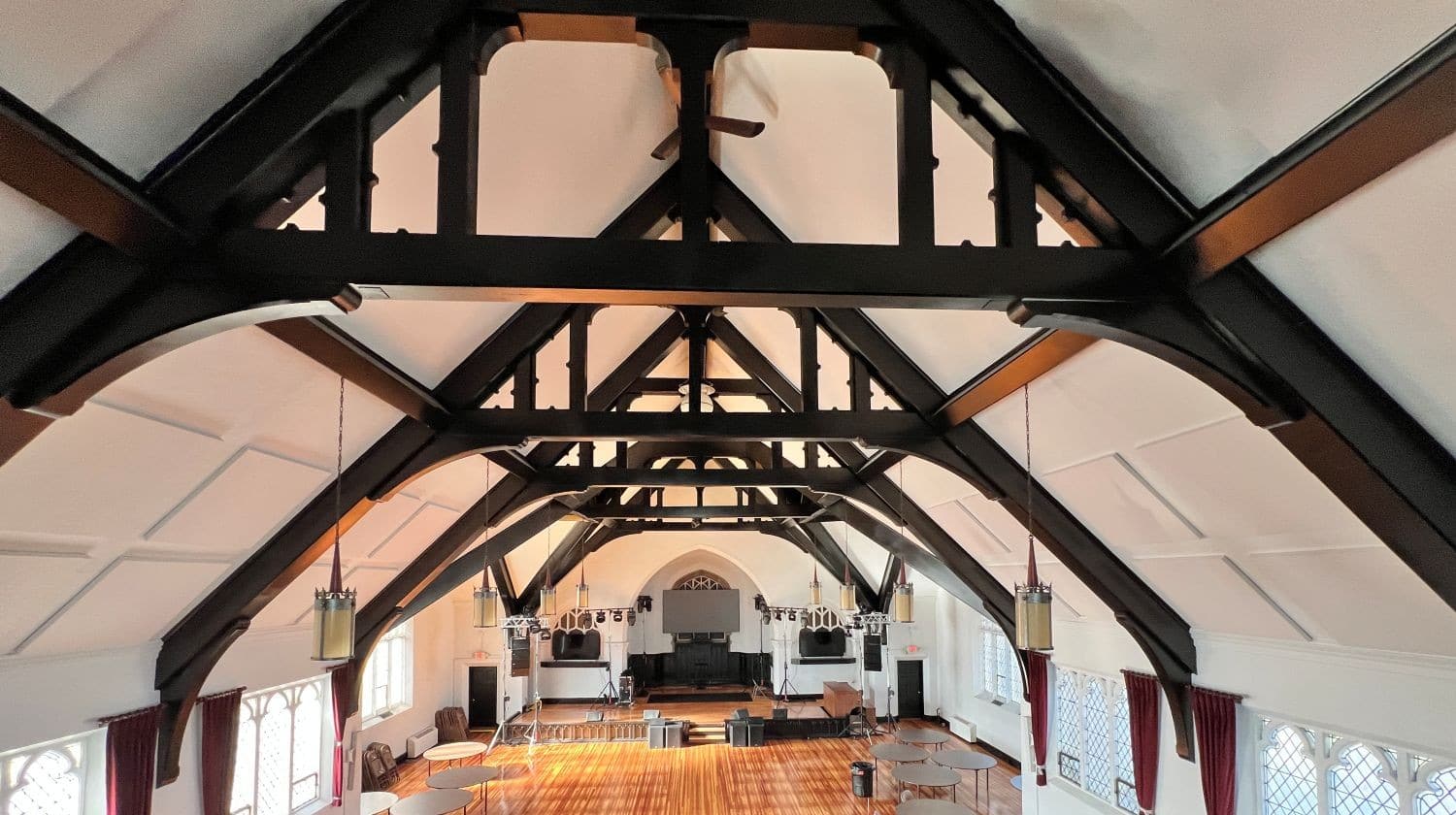When we think of churches and fellowship halls, we often think of the visual beauty—stained glass, vaulted ceilings, wooden pews, and open spaces that invite community and worship.
Yet one of the most overlooked aspects of these spaces is sound. Acoustics play a central role in how sermons, prayers, music, and conversations are experienced.
Good acoustics elevate the worship experience, while poor acoustics can cause distraction, fatigue, and a diminished sense of connection.
In this article, we’ll explore the fundamentals of acoustics in sacred spaces, the challenges many churches face, and the strategies available to improve reverberation, speech clarity, and overall comfort.
Why Acoustics Matter in Churches
Churches are unique spaces because they are designed for multiple functions. On Sunday morning, the sanctuary may host choirs, live bands, or organ music. Later that afternoon, the fellowship hall may host a luncheon, meeting, or children’s activity. Each use comes with different sound requirements.
- Speech intelligibility is critical during sermons, scripture readings, and announcements. If reverberation time is too high, spoken words blur together, leaving listeners straining to follow.
- Music clarity and warmth matter for choirs, organs, and contemporary bands. While some reverberation enhances music, too much can overwhelm the performance.
- Community comfort is equally important. Excessive echo and noise can make it difficult for people to enjoy fellowship meals, prayer groups, or casual conversations.
Ultimately, when the acoustics are poor, congregants may walk away frustrated or fatigued—something we all want to avoid.
Understanding Reverberation and Noise
At the core of acoustic comfort is reverberation time (RT60)—the length of time it takes for sound to decay by 60 decibels after the source has stopped. Simply put, the higher the reverberation time, the more echo and noise build-up is present. High reverberation time are common in large spaces with lots of hard, reflective surfaces.
- In a cathedral-style space, reverberation times can exceed four seconds, which may sound beautiful for organ music but muddle speech.
- In a modern fellowship hall with hard surfaces like concrete floors and drywall, echoes can make even small gatherings noisy and fatiguing.
- The ideal reverberation for speech-focused environments is typically between 1.0 and 1.5 seconds, while music-focused spaces often benefit from slightly longer times.
Excessive noise is also an issue. HVAC systems, street traffic, or even adjacent classrooms can contribute to distractions that diminish the worship experience.
Common Acoustic Challenges in Worship Spaces
Large Volumes and High Ceilings
Sanctuaries are often built with tall ceilings that create long reverberation times. Sound lingers, making speech harder to understand.
Reflective Surfaces
Stone, glass, wood, and drywall are common building materials in churches, but all reflect sound. Without adequate absorption, this creates echoes and muddiness.
Multipurpose Use
Fellowship halls double as event venues, dining spaces, classrooms, and meeting rooms. A single untreated space must accommodate vastly different acoustic needs.
Historic Buildings
Many churches are housed in older buildings where design changes must be subtle and aesthetically sensitive. Acoustic solutions need to be discreet or customizable.
Strategies for Improving Acoustics
Improving church acoustics requires a thoughtful blend of absorption, diffusion, and noise control. Each solution should be tailored to the unique size, design, and use of the space.
Acoustic Wall Panels
Fabric-wrapped acoustic wall panels absorb mid- to high-frequency sound, reducing reverberation and echo. They can be designed in custom colors, shapes, and sizes to complement the architecture of a sanctuary or hall. Higher-end acoustic panels made out of wood or felt can also be used. Just make sure you use products with a high NRC (Noise Reduction Coefficient).
Ceiling Treatments
Acoustic ceiling clouds and baffles are particularly effective in large sanctuaries with high ceilings. By strategically suspending treatments overhead, sound reflections are reduced while maintaining an open and airy appearance.
Sound Diffusion
Diffusers scatter sound energy rather than absorb it, maintaining a lively, natural sound while avoiding harsh echoes. In spaces where music is a priority, diffusion helps create warmth and balance.
Sound Masking and Noise Barriers
In churches with classrooms or offices adjacent to the sanctuary, privacy is a concern. Sound masking systems, door treatments, or various noise barriers can help reduce sound transfer between spaces.
The Process: From Assessment to Installation
Every worship space is unique, which is why a professional assessment is the first step toward effective acoustic improvement.
- On-site acoustic assessment – Measuring reverberation, analyzing room use, and identifying problem areas.
- Custom recommendations – Selecting the right mix of panels, baffles, diffusers, or barriers based on the space’s needs.
- Design integration – Offering custom finishes and discreet mounting options that respect the sacred architecture of churches.
- Professional installation – Ensuring that the treatments are properly placed for maximum acoustic benefit.
Some congregations may choose to work with an acoustic consultant who can provide detailed modeling, layouts, comprehensive reports, and product recommendations. Others may prefer to save money and work with a reputable company that can offer simple, turnkey solutions that still achieve significant improvements.
Benefits of Acoustic Treatment
Investing in acoustic treatment brings both immediate and long-term benefits for congregations. Improved speech intelligibility makes sermons and scripture easier to understand, while enhanced musical experiences allow choirs, bands, and organs to sound full and balanced.
These treatments also create greater comfort during gatherings by reducing echo and background noise for meals, meetings, and community events.
Perhaps most importantly, effective acoustic design fosters a more welcoming environment, ensuring that all congregants—regardless of age or hearing ability—can fully participate in worship.
When acoustics are optimized, the space becomes more inviting, encouraging engagement and growth within the congregation.
Acoustics are an invisible but powerful element of church life. While stained glass, woodwork, and architecture inspire the eyes, it is sound that inspires the ears and connects the heart.
By addressing reverberation, speech clarity, and noise control, churches can ensure that every sermon, song, and conversation is experienced with clarity and comfort.
This article is courtesy of DDS Acoustical Specialties, which is proud to partner with churches to create worship spaces where sound enhances, rather than hinders, the experience of faith and community, www.ddsacoustical.com.













